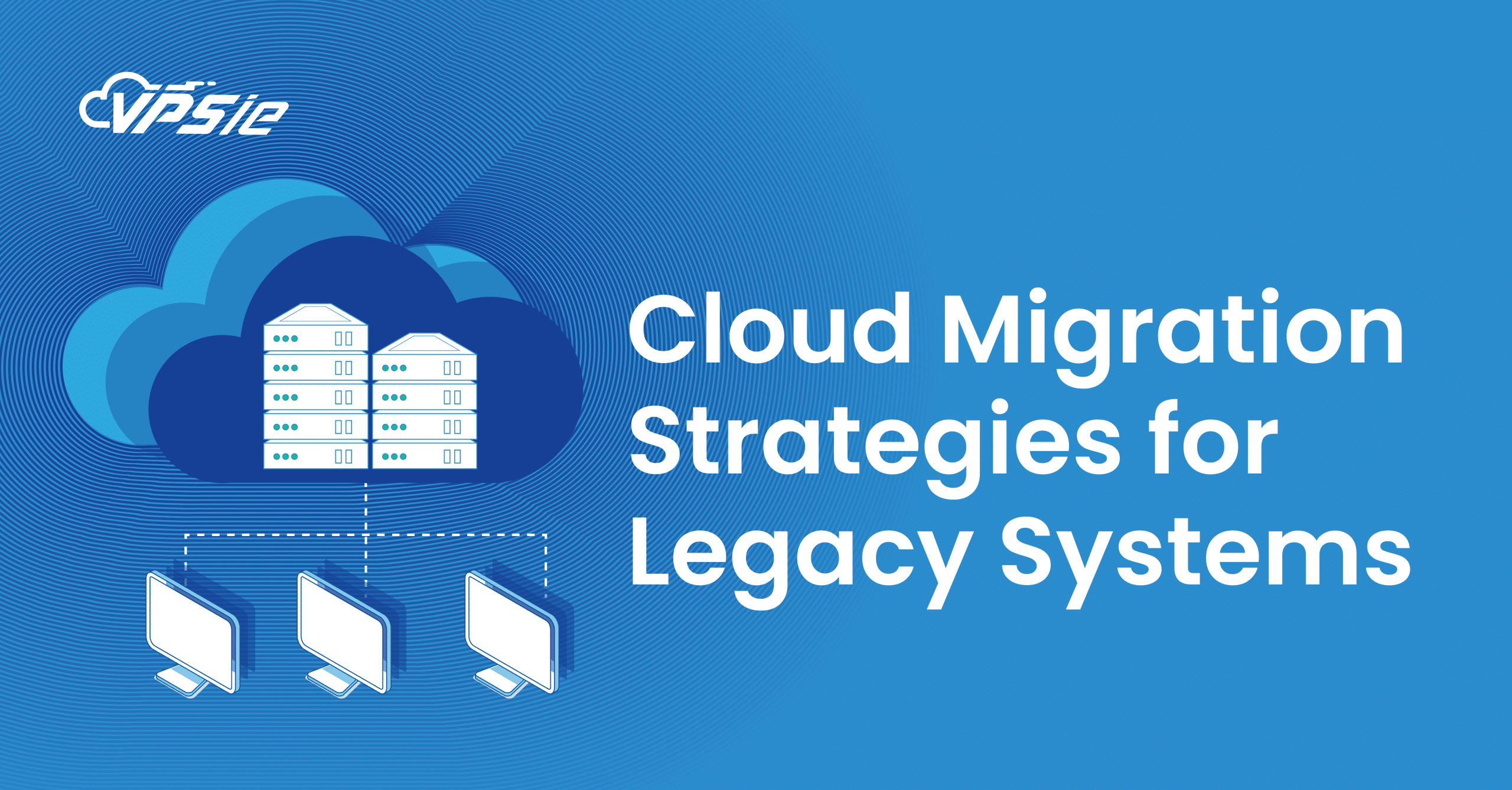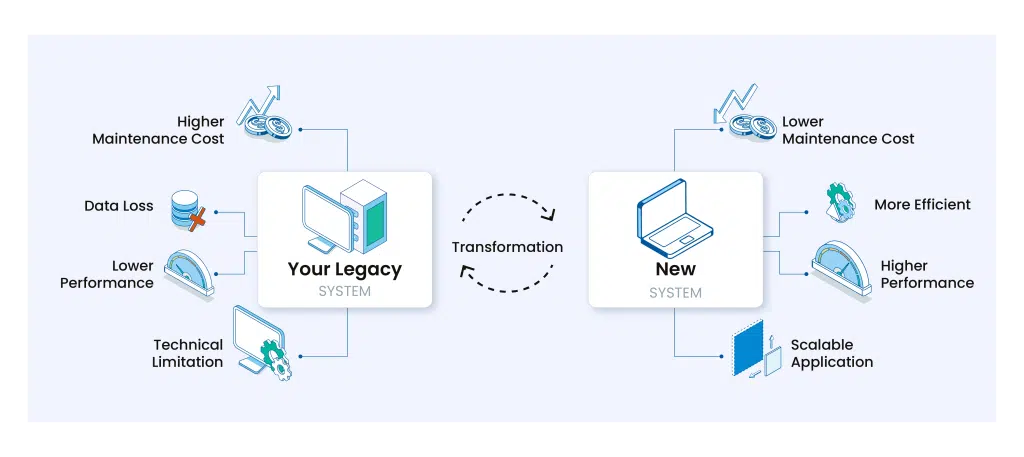As businesses and organizations undergo growth and transformation, the dynamic landscape necessitates an adjustment in their technological requirements and infrastructure. Legacy systems, characterized by outdated hardware or software that has become inefficient or obsolete, can impede progress and hinder overall productivity. A viable strategy to modernize these legacy systems involves transitioning them to the cloud, unlocking a plethora of advantages such as heightened scalability, accessibility, and security.
Within this guide, we will delve into a comprehensive exploration of the process of migrating legacy systems to the cloud. This will encompass an examination of the benefits and challenges inherent in the transition, an exploration of the diverse cloud services available, and a detailed, step by step walkthrough for executing a seamless migration.
Upsides of Shifting Legacy Systems to the Cloud
Moving your older systems to the cloud brings many perks, like:
1. Scalability
The migration of legacy systems to the cloud brings forth a multitude of advantages, with scalability standing out as a paramount benefit. Traditional on-premises environments often grapple with the complexities and time constraints of scaling to meet growing demands. This typically entails arduous hardware upgrades and intricate manual configurations. Contrastingly, the cloud offers a more streamlined and flexible approach to scaling.
Enter the VPSie App Engine, an innovative solution that boasts automatic scaling of resources in response to fluctuating traffic, thanks to its advanced auto-scaling capabilities. Legacy systems can seamlessly tap into these services, experiencing heightened scalability without the intricacies of cumbersome hardware upgrades.

Beyond the simplicity of scaling resources, cloud providers like VPSie present an array of supplementary tools to enhance scalability, including the invaluable load balancing feature. Load balancing efficiently distributes incoming traffic across multiple instances of a system, elevating overall performance and mitigating the risk of system failure. Another one is Auto-scaling, it complements this by dynamically adjusting resource allocation in response to demand, allowing systems to effortlessly navigate traffic spikes without manual intervention.
In essence, scalability emerges as a pivotal advantage when migrating legacy systems to the cloud, ushering in notable improvements in performance, stability, and efficiency. The array of scalable services and tools offered by cloud providers empowers legacy systems to adapt seamlessly to growth and fluctuations in demand, ultimately fostering a more robust and efficient operational landscape.
2. Accessibility
Enhancing accessibility stands out as a pivotal advantage when transitioning legacy systems to the cloud. By relocating your systems to the cloud infrastructure, you unlock the potential for global accessibility, allowing users to connect from any corner of the world, granted they possess an internet connection. This marks a notable departure from the limitations imposed by conventional legacy systems, confined to a single location, thereby complicating data sharing and collaboration for teams spread across diverse physical locations.
Moreover, beyond the realm of accessibility, cloud-based systems consistently outperform on-premise legacy systems in terms of security. Cloud service providers are obligated to conform to rigorous security standards, frequently leveraging cutting-edge technologies such as encryption, multi-factor authentication, and robust intrusion detection and prevention systems. This dual advantage of enhanced accessibility and fortified security positions cloud migration as a strategic move for organizations seeking to modernize their technological infrastructure.
3. Cost savings
Migrating legacy systems to the cloud presents a myriad of advantages, with one of the most notable being the potential for significant cost savings. Unlike traditional on-premises setups that demand a substantial upfront investment in hardware, software, and infrastructure, accompanied by ongoing maintenance and upgrades, cloud computing revolutionizes this financial landscape.
Organizations have the freedom to pay only for the resources they actively utilize, typically following a subscription based model. This shift translates into substantial, long term cost savings. Through this transition, organizations can pivot from the burden of capital expenses associated with on-premises systems and embrace an operational expense model that is not only more predictable but also inherently scalable.
Cloud service providers extend a spectrum of pricing models, catering to diverse organizational needs. These encompass pay-as-you-go, reserved instances, and spot instances, each offering a tailored approach to resource consumption. This flexibility empowers organizations to dynamically adjust their resource usage in real time, ensuring that financial resources are not squandered on redundant or superfluous capacity.
4. Performance
One compelling motivation for organizations to migrate their legacy systems to the cloud is the quest for enhanced system performance. On-premises hosting of legacy systems often limits performance, as it is bound to the available resources within the organization, including hardware and network capabilities. In stark contrast, cloud providers present a tempting solution, equipped with abundant resources and cutting-edge technology poised to elevate system performance to new heights.
A prime example of this transformative potential lies in cloud computing, where the dynamic allocation of processing power and storage unfolds, enabling a more streamlined and efficient utilization of resources. This dynamic allocation translates into accelerated response times, minimized latency, and an overall boost in system availability. Beyond resource provisioning, cloud providers offer an array of tools and services designed to amplify system performance. Features like load balancing, auto-scaling, and the deployment of content delivery networks contribute to optimizing system functionality and responsiveness. In essence, the cloud emerges as a catalyst for a shift, offering a performance-enhancing environment that surpasses the constraints of traditional on-premises hosting.
5. Enhanced security
Old platforms often don’t have strong security features needed to fight modern cyber threats. They also struggle to meet industry standards and get important certifications. Switching to new software can fix these issues and make sure you follow the rules. It gives you better security with advanced encryption, strong multi-factor authentication, and keeps an eye out for problems. This upgrade not only protects you from cyber threats but also makes it easier to follow the rules, making your tech setup safer and more reliable.
Facilitating Seamless Migration with VPSie Support
VPSie emerges as a valuable ally for organizations seeking a smooth transition from legacy systems. VPSie’s robust support system facilitates the migration process, providing organizations with options to consult with the VPSie Team. This collaborative approach ensures a tailored strategy for migrating legacy virtual machines to the VPSie platform, leveraging its advanced features and services.
Unlocking Advantages with VPSie App Engine
Within the broader context of cloud migration, the VPSie App Engine stands out as an innovative solution, offering automatic scaling of resources in response to varying traffic demands. This feature streamlines the scalability process, allowing legacy systems to adapt seamlessly without the complexities of manual intervention or hardware upgrades. Organizations can engage with the VPSie Team to explore these capabilities, ensuring a customized approach to scalability that aligns with their specific needs.
In addition to automatic scaling, VPSie provides supplementary tools like load balancing, optimizing overall performance by efficiently distributing incoming traffic across multiple instances. This, coupled with auto-scaling, dynamically adjusts resource allocation, enabling legacy systems to navigate traffic spikes effortlessly. The collaborative efforts between organizations and the VPSie Team pave the way for a robust and efficient operational landscape.
Heading to New Horizons with VPSie Support
In conclusion, the incorporation of VPSie support into the cloud migration strategy offers organizations a comprehensive solution for transitioning from legacy systems. The collaboration with the VPSie Team ensures a seamless process, allowing businesses to harness the benefits of scalability, accessibility, cost savings, improved performance, and enhanced security. This strategic partnership with VPSie signifies a pivotal step towards a modernized and resilient technological infrastructure.

























